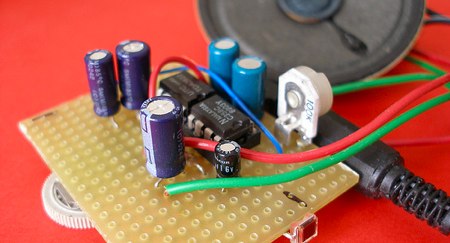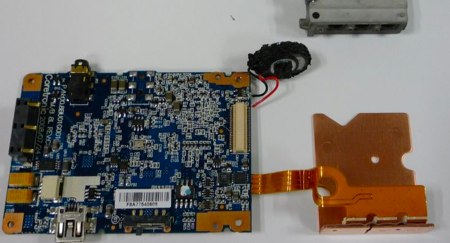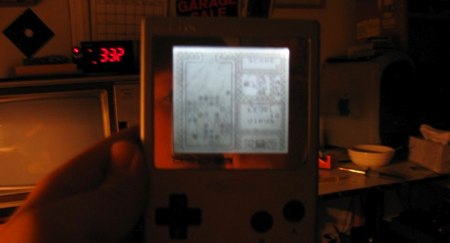Parts: Digital proximity sensor (Sharp GP2Y0D02)
The GP2Y0D02 is an infrared proximity sensor with a detection field that extends 80cm. This type of sensor can be used to build collision avoidance systems for robots. We'll demonstrate this sensor using a single resistor and a multimeter.

Sharp GP2Y0D02 fixed 80cm IR proximity detector (Digikey #425-2064-ND, $14.38). Datasheet (PDF).
The GP2Y0D02 requires a 5volt power supply (not shown). A 0.1uF bypass capacitor between power and ground (C1) is a good idea, but we didn’t use it in our demonstration. The open collector output (pin 1) pulls to ground when no object is detected, a 12K pull-up resistor (R1) holds the signal high when an object is detected.
In the demonstration we connected the output of the sensor to a multimeter. When nothing is in front of the sensor, the detector holds the output low (0.40volts). When we put a PCB in front of the sensor, the output changes to high-impedance and the pull-up resistor (R1) holds the signal high (5volts).
Why open collector?
An open collector output doesn’t toggle between high and ground, it toggles between ground and unconnected. The unconnected state, also called high impedance, exerts nothing on the output and allows the signal line to float. This is an undefined state for most microcontrollers that returns rapidly varying values, so we use a resistor (R1) to hold the signal high. The open collector output overcomes the small amount of current flowing through resistor to register the low state. Without this resistor, the output will never reach a proper high state.
Open collector outputs are useful when several sensors need to share the same microcontroller pin. Multiple sensors outputting high to the same microcontroller pin is generally considered a bad practice that can damage parts of a circuit. Multiple open collector outputs, however, can only switch to ground; a single resistor holds the signal high. In the case of multiple GP2Y0D02s, the signal will be high only when all connected sensors detect an object and switch to high impedance state.
Like this post? Check out the parts posts you may have missed.

Homebrew on the PSP3000
[matiaz] has released an exploit which allows homebrew on the PSP3000. It takes advantage of a vulnerability when loading save games on a game called GripShift. You can see the PSP running unsigned code in the video.
[thanks wraggy]

7 color hand held laser projector

[rog8811] sent in this really cool hack where he used the optics sled from a PS3 as a foundation for a 7 color hand held laser projector. Combining a green laser, a blue ray laser, and a red laser, he is able to produce a variety of color including white. There are step by step instructions on how to make a multicolored laser. He then goes even further, showing how to integrate this into a hand held projector with pre programmed patterns. You can see some examples of the different colors and patterns in this video.

Parallel parking system

Autoblog dug up this classic mechanical engineering project from 2006. A team of five University of Toledo students constructed a system to help parallel park a car. First, you drive nose first into the space. Hydraulic rams then lower the drive wheel out of the trunk, raising the rear of the car. The single wheel is also hydraulically driven and moves the car into the space. They have a blog documenting the six week build. Have a look at the demonstration video below.

Hacking at Random 2009 call for papers

With the Chaos Communication Congress concluded, it’s time to start looking towards the next massive European hacker event. This means Hacking at Random August 13-16th in the Netherlands. It’s a four day long camp experience that will feature many conference talks, interactive projects, and more.
The team has selected three tracks in their official call for papers: Dealing with data, Decentralization, and People and politics. You can find more details in the post. Deadline is May 1st.
[photo: mark]

Light to sound converter

[Alex] built what he calls a light to sound converter. It reacts differently depending on the type of light: remote controls, light bulbs, TV screens, etc. A photodiode is used with an amplifier to pick up the light change. That signal is dumped through a dual opamp. He swapped in several different types of photodiodes and settled on the BPW34 intended for visible light. He’ll be incorporating this into a much larger project.

Tiny projector teardown

The team from Tech-On has taken the time to teardown two interesting microprojectors. The first model they tackled was the Optoma PK101. It’s based around a digital micromirror device (DMD) like those used in DLP. Separate high intensity red, green, and blue LEDs provide the light source. A fly-eye style lens reduces variations between images. They noted that both the LEDs and processors were tied directly to the chassis to dissipate heat.
The next projector was the 3M Co MPro110. It uses Liquid Crystal on Silicon (LCoS) technology. The light source is a single bright white LED. The projector seems to have more provisions for getting rid of heat than the previous one. The most interesting part was the resin polarizing beam splitter. It not only reflected specific polarizations, but also adjust the aspect ratio.
[via Make]

Game Boy Pocket backlight

[palmertech] and [Bibin] have both completed backlight projects for the Game Boy Pocket recently. The most difficult part of the transplant is carefully removing the reflective backing on the LCD. After a thorough cleaning, a diffuser and backlight panel were added. [palmertech] used a backlight salvaged from a DS, while [Bibin] built his own using LEDs. You can see his backlight in the video embedded below. There’s a disassembly video too.
[via Engadget]

Washing machine generator

Building a generator can be a fun and fairly simple project. Getting a large DC motor however can sometimes be difficult. Here is a writeup on how to make a generator from an old washing machine drive. It looks like you might need to find a specific machine called the “Smart Drive” to follow their directions exactly though. If you happen to find one, or know of a unit with a similar motor, you can follow these directions to end up with a fairly decent wind powered generator.
[thanks TripleB]

The Malware Challenge

Our own [Anthony Lineberry] has written up his experience participating in the 2008 Malware Challenge as part of his work for Flexilis. The contest involved taking a piece of provided malware, doing a thorough analysis of its behavior, and reporting the results. This wasn’t just to test the chops of the researchers, but also to demonstrate to network/system administrators how they could get into malware analysis themselves.
[Anthony] gives a good overview of how he created his entry (a more detailed PDF is here). First, he unpacked the malware using Ollydbg. Packers are used to obfuscate the actual malware code so that it’s harder for antivirus to pick it up. After taking a good look at the assembly, he executed the code. He used Wireshark to monitor the network traffic and determine what URL the malware was trying to reach. He changed the hostname to point at an IRC server he controlled. Eventually he would be able to issue botnet control commands directly to the malware. We look forward to seeing what next year’s contest will bring.

Microwave timer switch

[Koil_1] knows he’s forgetful. In order to save himself from any undue harm, or possibly to keep from burning his house down, he felt he needed a timed power switch to run his soldering iron from. He realized he could harvest the relays and timer circuit from a microwave. This allows him to have presets for specific tasks. Considering the fact that you can get a used microwave for free or close to it most of the time, this was a great re use of something that might just go wasted otherwise. Great job [Koil_1].

Make: television premiering today

Make’s television series will be premiering on public television across the US over the next couple days. If it’s not showing in your area, you aren’t out of luck. All of the segments from the first episode have already been published online at makezine.tv.

Automated wire cutter and stripper

Kit builder oomlout—we’ve featured their servo bot—needed to produce a lot of precut wires. After cutting and stripping more than their fair share, they decided to apply some heavy engineering to make things easier. They constructed a machine to do the job for them. It has three main components: a servo driven wire feeder to measure the length, a two servo wire stripper that uses an exacto blade, and finally a wire cutter made from snips and a drill motor. The machine is controlled using an Arduino. They’ve published all the plans and code to Thingiverse incase anyone else wants to build a similar machine for their own kit shop. A video of the machine is embedded below.
[via Hack a Day Flickr pool]

You received this email because you are subscribed to the real_time feed for http://hackaday.com/feed/. To change your subscription settings, please log into RSSFWD.




